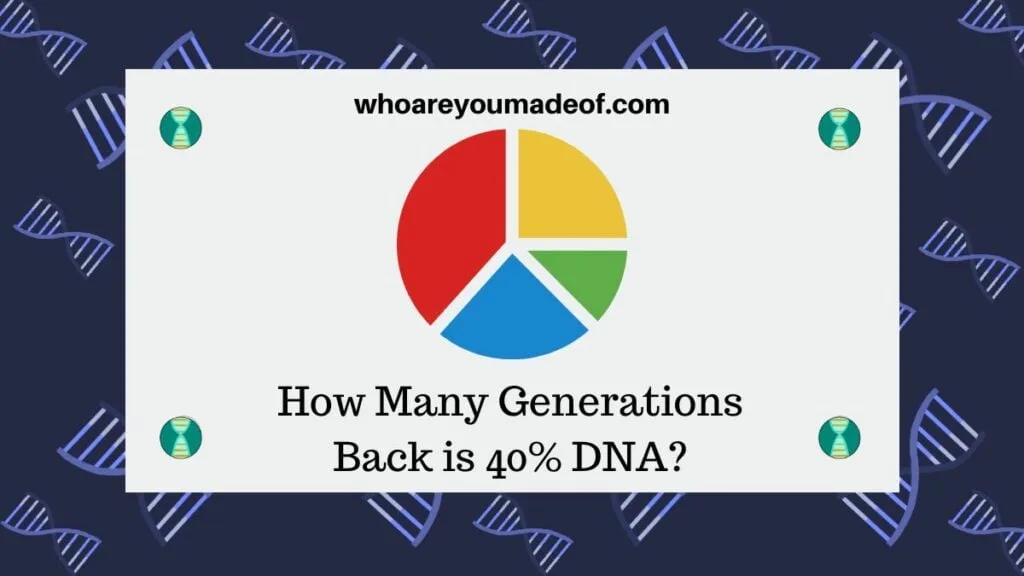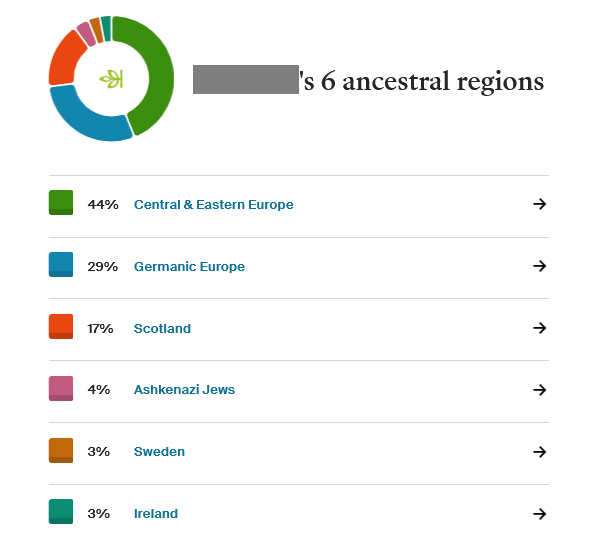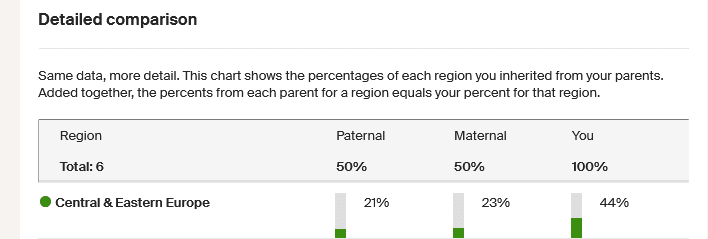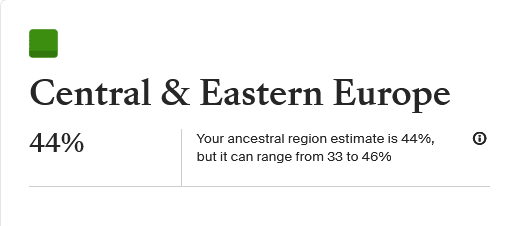Did you get more than 40% matching a single region on your DNA results? In this post, learn how many generations back this is, as well as everything you need to know to find the ancestor who passed this down to you.

How many generations back to 40% DNA region ancestor
There are a few different ways to think about how many generations back we need to go in our family to find our "DNA ancestor", or the person who passed down a specific region in our DNA results to us.
The first method is very simple, yet has obvious flaws, which I will discuss after I explain how to use it.
Simple rule of thumb for calculating generations back to DNA ancestor
To estimate where you might need to look in your family tree to find the ancestor, or ancestors, who belonged to the region that showed up as more than 40% in your DNA results, you can start by using this simple rule of thumb: double the percentage of DNA until you get a number that can't be doubled without being more than 100.
This method works best if you feel certain that all or most of the DNA that you inherited matching this region came from only one side of your family tree.
The number of times that you double the number is the number of generations back you need to look. The larger the percentage that you are doubling, the fewer number of generations it will be.
For example, if we had 20% DNA matching a region, we could double it once and get 40% (our parents' generation). If we double it again, we get 80% at our grandparents' generation, which is pretty close to being a "100% ancestor".
We can't double it again because we would be much higher than 100%.
Using the logic of this rule of thumb, we could theoretically conclude that if we had 20% DNA matching one region, one of our grandparents would have shown more than 80% of their DNA matching that same place.
We can do the same calculations using our 40% number, but we only have to double it once to get to a number that cannot be doubled without being greater than 100. This means that using this very basic rule of thumb, if you have 40% of DNA matching any single region, one of your parents could have been essentially 100% of that ethnicity.
Why the "doubling each generation" method might not work in your case
Doubling our ethnicity percentage each generation doesn't always work for a few reasons. The most important one to understand is that ethnicity (i.e. an ancestral region on your results) is not always passed down in equal 50% percentages.
If your parent had 60% matching that region, you could show anywhere between 20-50% of your DNA matching that ethnicity on your results.
You might have ancestors from that region on both sides of your family
If there is a possibility that both of your parents might have a similar ancestral background, then doubling 40% to get to 80%, and thus, the ancestor who passed down the DNA to you might not work. This is because if both of your parents had similar origins, you may have inherited DNA matching this region from both of them.
When this happens, it can mean one of three things:
- Scenario A - You have one ancestor on each side of your family who was from this region and passed it down to you, or you are from this region yourself
- Scenario B - You have many recent ancestors from this region on both sides of your family
- Scenario C - You have many distant ancestors from this region on both sides of your family
You might be able to quickly figure out which situation likely applies to you based on what you know about your family tree.
Scenario A
For example, if you know that both your parents had one parent from Mexico, and you show that 40% of your DNA matches the Indigenous Americas - Mexico region on Ancestry, you likely inherited at at least a portion of the 40% from both of your parents.
If you are from Mexico, took a DNA test and showed up with 40% Native Americas - Mexico on your results, it is very likely that both of your parents have indigenous American ancestry. This means that you are descended from the indigenous peoples of North America and the other DNA percentages in your results were inherited from ancestors who came to live in Mexico from other parts of the world.
Scenario B
Some people are the children or grandchildren of recent immigrants to where you live. In this case, you might expect that the 40% of your DNA matching a single region was inherited because all of your recent ancestors have roots in that region.
For example, if you know that both of your parents and all of your grandparents were born in Senegal, you could assume that your 40% DNA matching the Senegal DNA region was inherited from both sides of your family due to their deep roots in that country.
Scenario C
In this scenario, most lines of your family tree have been living in a country that your ancestors immigrated to many generations ago, and both of your parents have ancestral ties to these immigrants.
A good example of this is people who are descended from some of the first major groups of immigrants to North America. The majority of immigrants to North America between 1600-1800 were from the British Isles.
Thus, many people who are descended from families who immigrated to the US or Canada before or during colonial times will show large percentages of DNA matching the England and Northwestern Europe DNA region.
For example, my paternal grandmother shows that 77% of her DNA matches the England and Northwestern Europe DNA region, but only 3 of her 16 great-great grandparents were born in England. This accounts for only about 18.75% of her DNA.

The rest of the 77% was passed down from many much more distant ancestors. From what I have been able to learn about her family tree, there are no other immigrants to North America going back several generations from the other lines in her tree.
This means that about 50% of her DNA from the England and Northwestern Europe was passed down in very small percentages from a large number of very distant ancestors.
Example of 40% matching one region on DNA results and how to find "the ancestor" who gave it to you
To help you understand how to know how far back the ancestor (or ancestors!) who passed down a single region matching your DNA at more than 40% might be, I decided to include an example from my mother's DNA results and how I know where her ancestry from that region came from.
On the most recently updated version of Ancestry DNA results, my mother's ancestral origin report (previously known as an ethnicity estimate) shows that my mother has 44% of her DNA matching the Central & Eastern Europe region.

Below, I'll quickly walk you through my recommended research steps for finding out how far back in your family tree you need to look for the ancestor, or ancestors, who passed down your 40% DNA region to you.
Build a family tree
The most important thing you can do to learn more about the 40% region on your results is to start building a simple family tree. You can start a family tree for free on Ancestry, but there are lots of other sites you can use, too.
Talk with your parents or other relatives to learn what they know, add this information to your tree, and then use genealogy records to learn even more. You might find that you quickly discover which ancestors had roots in the part of the world that you want to learn more about.
In my mother's case, this was also the first thing that I did since I did not know where all of her grandparents were born.
It turns out that both of my mother's parents had roots in Central and Eastern Europe. Her mother's father was 100% of Polish descent and her father's father was 100% of Slovak ancestry.
Use DNA to find out which side of the family the ancestry is on
You can use your DNA results and those of other relatives to find out which side of the family you inherited your "40% region" from. This can help you narrow down where to look in the family tree that you are building.
When I first did my DNA test, I didn't have access to a lot of the advanced tools that are available now. What made things even more complicated was that almost no one else in my family had tested.
Fortunately, things are different now and many people have at least one close-ish relative who has also tested. And by "close-ish", I mean anyone who isn't a distant cousin (i.e. related at a third cousin relationship or closer).
Ancestry SideView
If you did your DNA test on Ancestry, you can use a Pro Tools subscription to see whether your DNA region was inherited from Parent 1 or Parent 2, or both. This feature is called the ancestral regions By Parent tool.
When I checked this for my mom's results, this is what I saw

From the image above, you will note that my mom inherited almost equal amounts matching the Central and Eastern Europe region from her mother and father. Furthermore, the percentages align with my mother having one grandparent on each side of the family born in the region, since we usually share about 25% of our DNA with each of our grandparents.
When researching this question, I have to be careful to not fall into the trap of assumptions. Even though the percentages seem to line up neatly with what we might expect to inherit from a grandparent, I know that family trees and ethnicity/ancestral origins inheritance can be complicated.
My mother also has German ancestry on her mother's side of the family. Since Germany is very close to Poland and Slovakia, it is conceivable that she could have inherited some DNA matching this region from her German anestors.
Asking another relative to test
Another step you can take to learn about your 40% DNA region, or any of the regions that show up on your results, is to ask another relative to take a DNA test. Parents and grandparents are the best choice, but siblings, aunts and uncles, and even great-aunts and uncles can also be very helpful in learning more about your family's origins.
Their DNA results can help you figure out which line of your family tree the ancestor who passed down your "40% DNA region" to you is on.
Compare ethnicity regions with DNA matches
If you have close DNA matches on the site where you tested, and you know how you are related to those people, it can be helpful to compare your DNA regions to theirs. If you know the ancestor that you share in common, you can use whether or not your share that DNA region in common to determine which line of your tree the ancestry is from.
Is 40% of an ethnicity region ever a mistake?
If you did your DNA test with one of the major DNA testing companies, you can feel confident that any region matching more than 40% of your DNA is correct. While you might see the name of the region change over time as our results become more refined.
On this topic, it is important to know that many of the DNA testing companies include a range for each region that shows in our DNA results. On Ancestry, you need to click on the region in your ancestral regions report to see further details about the range that corresponds to your DNA.
For example, on my mother's results, I see that the range matching Central and Eastern Europe is 33-46%. Everyone will see different ranges on their results, so it's important to check to see the range when you are researching a region.

Conclusion
I hope that this post has helped you understand how to think about where you got your 40% (or more!) matching a specific DNA region. If you have any questions about something that you read in this post, or if you would like to share how you figured out which ancestor your DNA came from, please join in the discussion below.
Thanks for reading today!
